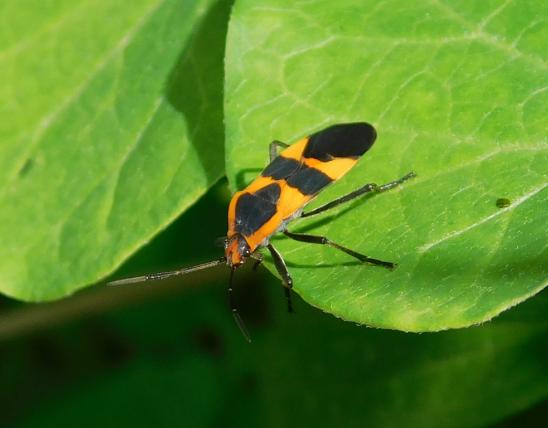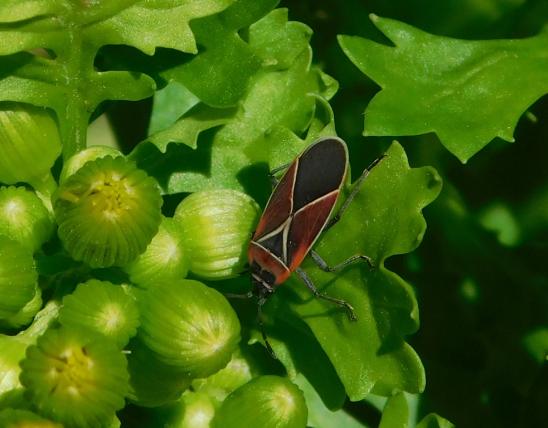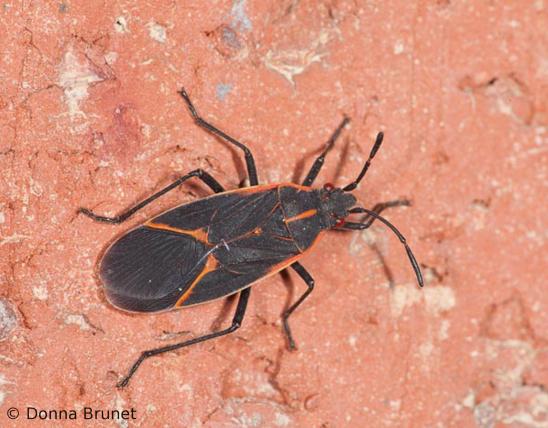
The small milkweed bug is a widespread species. Identify it from other, similar-looking true bugs by its smallish size (only to about ½ inch long) and its special orange-and-black pattern: note the reddish-orange X on the back and a reddish-orange band running across the pronotum (the pronotum is the shield-like plate, like shoulders, between the head and wings). The reddish-orange pronotum band has two black spots on its front edge; on the hind edge are two half-circles of black, which, combined with the big black triangle-shaped mark in the middle of the back, looks like a black heart-shape. Also note the black head with a red spot on top.
There are about 80 species of seed bugs in North America north of Mexico, and some of them look quite similar. Learn more about this and other seed bugs on their group page.
Similar species:
- The false milkweed bug (Lygaeus turcicus) looks very similar. However, it has a very different diet: it prefers to eat the seeds of false sunflower or ox-eye (Heliopsis helianthoides), in the sunflower family, instead of milkweeds. We must assume it is not toxic to its predators. To identify it, note that instead of a big black, rather conventional heart-shape on the back, its roughly triangular black mark is notched at the sides with orange, making it look like two overlapping black triangles or hearts. Also, it has a T- or Y-shaped orange mark on its head instead of a red dot on the head between the eyes. The food plant may be the biggest clue.
- The large milkweed bug (Oncopeltus fasciatus) also has a bold black-and-orange pattern and also is found in open areas, feeding on milkweeds. On average, however, large milkweed bugs are larger, about ½–1 inch long, and their orange-and black pattern is different. In the large milkweed bug, each forewing has, from front to back, an orange, front-pointing triangle, a wide black band, and an orange backward-pointing triangle; then, the outer, membranous portion of the forewing is black. Also note that the pronotum has a black, forward-pointing triangle bordered on either side by orange.
- The eastern boxelder bug (Boisea trivittata) is not in the seed bug family, but it also has red markings that sometimes form an X on the back, and there is a red line along the outer edge of the closed wings. It has a thin red line running down the back of the pronotum instead of a bold red band running from side to side. Boxelder bugs live on and near their food plant, the box elder tree. Since box elders are very common around homes and in towns, boxelder bugs are very commonly seen in fall when they swarm on the sunny sides of houses, looking for warm nooks where they can spend the winter.
Adult length: about ½ inch.
Statewide.
Habitat and Conservation
Usually found in open, grassy areas where its principal food plants (milkweeds) and other wildflowers are growing.
Food
Small milkweed bugs eat a variety of foods, including flower nectar, sap from milkweed seeds, and a variety of scavenged foods. They are also predators of caterpillars as well as the adults, larvae, and pupae of flies, bees, and beetles. Apparently, once milkweed seeds are maturing around midseason, small milkweed bugs mainly eat them. As with other true bugs, this insect uses its long, strawlike mouthparts to pierce its foods and suck nutritious juices.
Life Cycle
Females deposit eggs on milkweed plants in the spring. There is at least one generation a year, with adults overwintering. This species is usually seen in Missouri from June until the first hard freezes occur in October.
Ecosystem Connections
Like many insects that feed on milkweeds, their contrasting black and bright orange colors are a warning to potential predators. As they feed on milkweeds, whose sap contains toxic chemicals, their bodies are able to sequester the toxins so that a predator that eats them will be sickened. The bright colors are memorable, which helps teach predators not to eat creatures that look like them in the future.
There are a wide variety of insects that feed on milkweeds and become distasteful, including monarch butterflies, milkweed bugs, milkweed longhorn beetles, milkweed leaf beetles, and milkweed tussock moth caterpillars. All of these are either orange and black or red and black, sending a clear message to would-be predators: “Don't eat me; I taste terrible.”
The similar-looking, but apparently not toxic false milkweed and boxelder bugs might be mimics of small milkweed bugs, gaining protection from predators by resembling a toxic species.




























